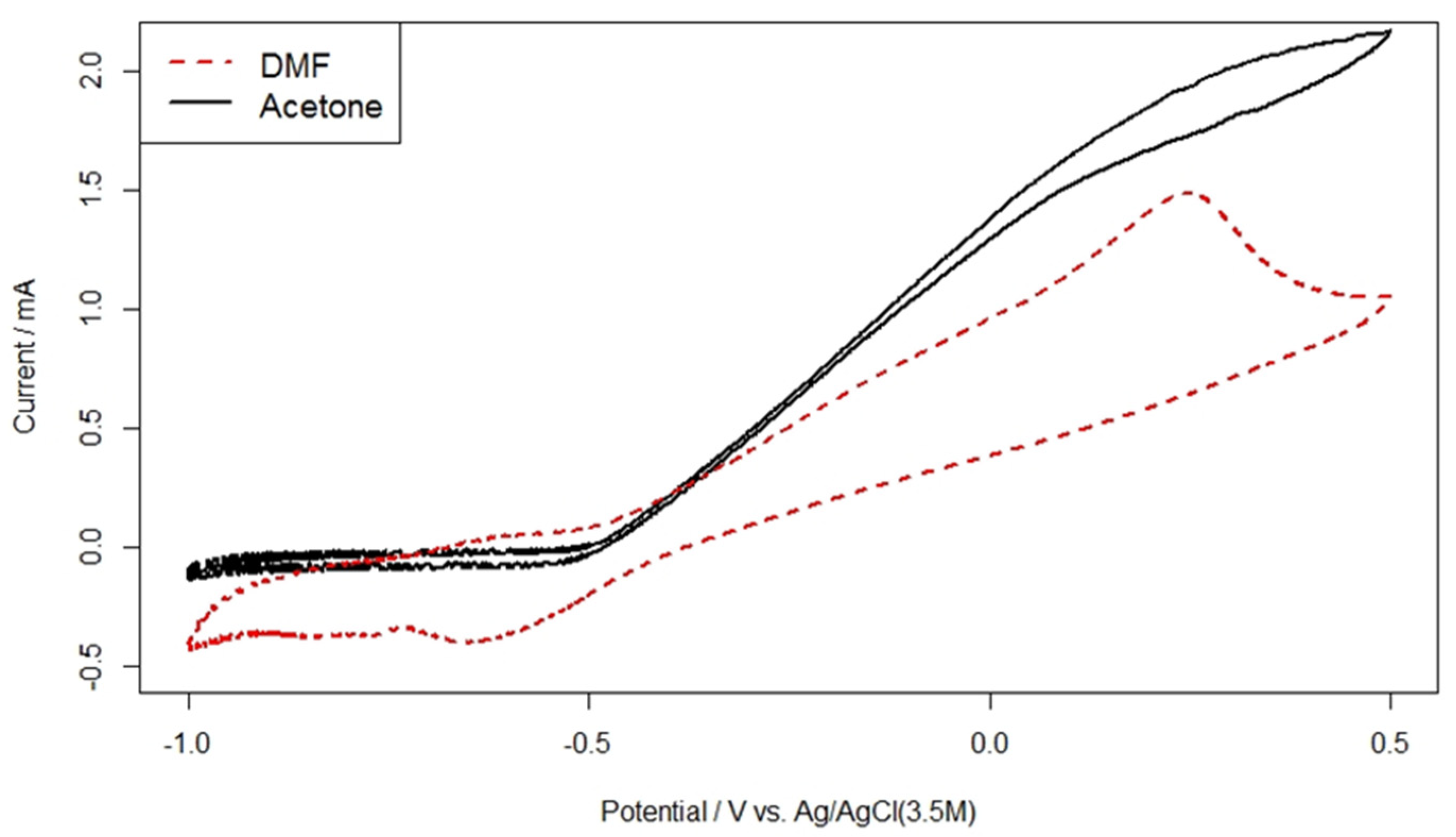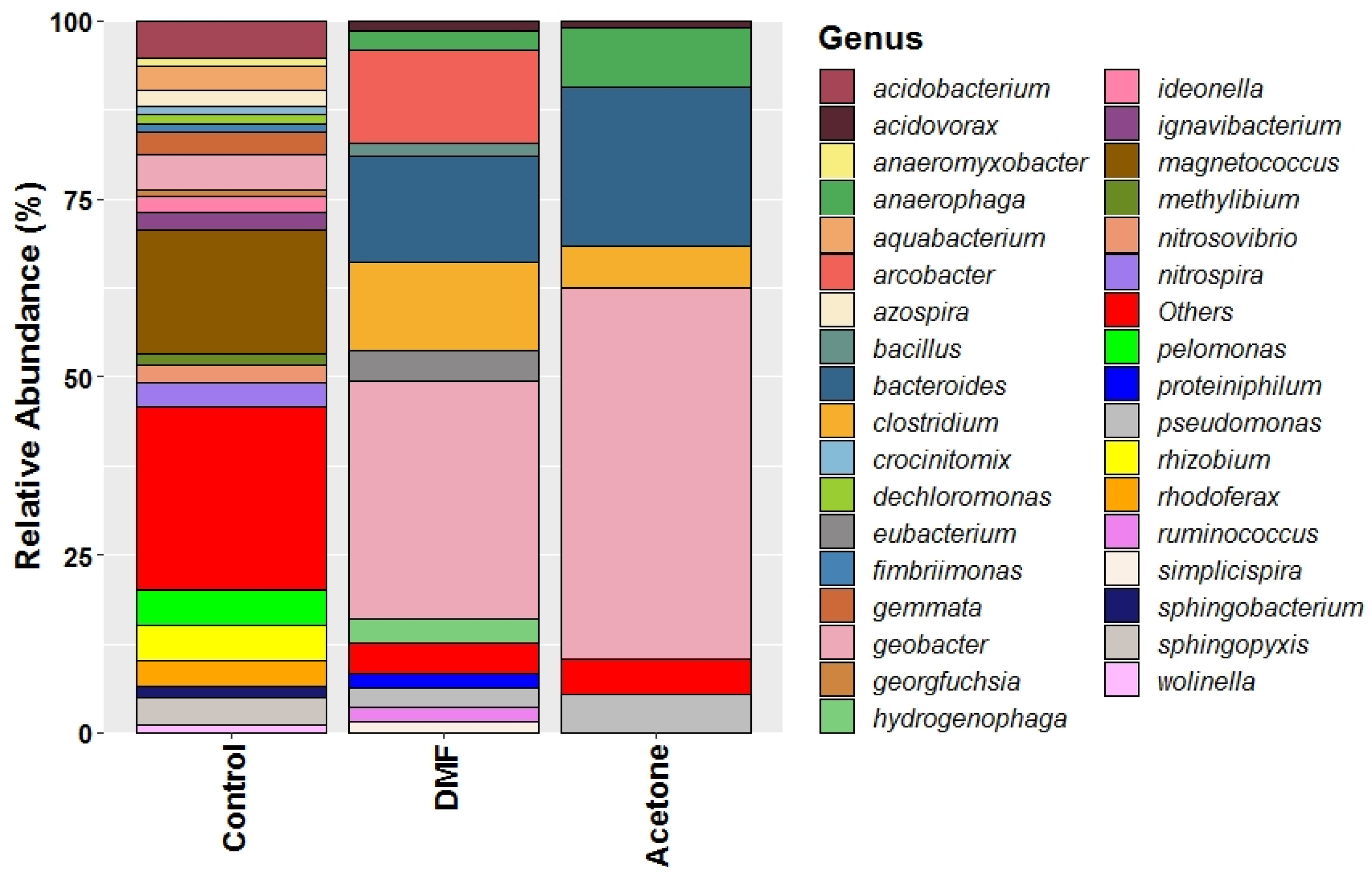Comparison of Activation Methods for 3D-Printed Electrodes for Microbial Electrochemical Technologies
Abstract
:1. Introduction
2. Materials and Methods
2.1. Electrodes Manufacturing and Activation
2.2. Electrochemical Characterisation Apparatus and Reagents
2.3. Bioelectrochemical Tests
2.4. Microbial Community Analysis
3. Results and Discussion
3.1. Electrodes Characterisation in Abiotic Conditions
3.2. Electrodes Characterisation in Biotic Conditions
3.3. Microbial Community Analysis
4. Conclusions
Supplementary Materials
Author Contributions
Funding
Institutional Review Board Statement
Informed Consent Statement
Data Availability Statement
Conflicts of Interest
References
- Schröder, U.; Harnisch, F.; Angenent, L.T. Microbial Electrochemistry and Technology: Terminology and Classification. Energy Environ. Sci. 2015, 8, 513–519. [Google Scholar] [CrossRef]
- Alonso, R.M.; San-Martín, M.I.; Sotres, A.; Escapa, A. Graphene Oxide Electrodeposited Electrode Enhances Start-up and Selective Enrichment of Exoelectrogens in Bioelectrochemical Systems. Sci. Rep. 2017, 7, 1–10. [Google Scholar] [CrossRef] [PubMed] [Green Version]
- Zhang, P.; Liu, J.; Qu, Y.; Li, D.; He, W.; Feng, Y. Nanomaterials for Facilitating Microbial Extracellular Electron Transfer: Recent Progress and Challenges. Bioelectrochemistry 2018, 123, 190–200. [Google Scholar] [CrossRef] [PubMed]
- Kaur, R.; Marwaha, A.; Chhabra, V.A.; Kim, K.-H.; Tripathi, S.K. Recent Developments on Functional Nanomaterial-Based Electrodes for Microbial Fuel Cells. Renew. Sustain. Energy Rev. 2020, 119, 109551. [Google Scholar] [CrossRef]
- San-Martín, M.I.; Escapa, A.; Alonso, R.M.; Canle, M.; Morán, A. Degradation of 2-Mercaptobenzothizaole in Microbial Electrolysis Cells: Intermediates, Toxicity, and Microbial Communities. Sci. Total Environ. 2020, 733, 139155. [Google Scholar] [CrossRef] [PubMed]
- Strack, G. Additive Manufacturing Approaches for Biological Power Generation. Curr. Opin. Electrochem. 2019, 17, 167–173. [Google Scholar] [CrossRef]
- Chiranjeevi, P.; Patil, S.A. Strategies for Improving the Electroactivity and Specific Metabolic Functionality of Microorganisms for Various Microbial Electrochemical Technologies. Biotechnol. Adv. 2019, 39, 107468. [Google Scholar] [CrossRef] [PubMed]
- O’Neil, G.D.; Ahmed, S.; Halloran, K.; Janusz, J.N.; Rodríguez, A.; Terrero Rodríguez, I.M. Single-Step Fabrication of Electrochemical Flow Cells Utilizing Multi-Material 3D Printing. Electrochem. Commun. 2019, 99, 56–60. [Google Scholar] [CrossRef]
- Kumar, K.P.A.; Ghosh, K.; Alduhaish, O.; Pumera, M. Metal-Plated 3D-Printed Electrode for Electrochemical Detection of Carbohydrates. Electrochem. Commun. 2020, 120, 106827. [Google Scholar] [CrossRef]
- Redondo, E.; Pumera, M. MXene-Functionalised 3D-Printed Electrodes for Electrochemical Capacitors. Electrochem. Commun. 2021, 124, 106920. [Google Scholar] [CrossRef]
- Zhang, J.; Li, X.L.; Fan, S.; Huang, S.; Yan, D.; Liu, L.; Valdivia y Alvarado, P.; Yang, H.Y. 3D-Printed Functional Electrodes towards Zn-Air Batteries. Mater. Today Energy 2020, 16, 100407. [Google Scholar] [CrossRef]
- Gusmão, R.; Browne, M.P.; Sofer, Z.; Pumera, M. The Capacitance and Electron Transfer of 3D-Printed Graphene Electrodes Are Dramatically Influenced by the Type of Solvent Used for Pre-Treatment. Electrochem. Commun. 2019, 102, 83–88. [Google Scholar] [CrossRef]
- Browne, M.P.; Novotný, F.; Sofer, Z.; Pumera, M. 3D Printed Graphene Electrodes’ Electrochemical Activation. ACS Appl. Mater. Interfaces 2018, 10, 40294–40301. [Google Scholar] [CrossRef] [PubMed]
- Marshall, C.W.; Ross, D.E.; Fichot, E.B.; Norman, R.S.; May, H.D. Electrosynthesis of Commodity Chemicals by an Autotrophic Microbial Community. Appl. Environ. Microbiol. 2012, 78, 8412–8420. [Google Scholar] [CrossRef] [PubMed] [Green Version]
- Yuan, H.-R.; Deng, L.-F.; Qian, X.; Wang, L.-F.; Li, D.-N.; Chen, Y.; Yuan, Y. Significant Enhancement of Electron Transfer from Shewanella Oneidensis Using a Porous N-Doped Carbon Cloth in a Bioelectrochemical System. Sci. Total Environ. 2019, 665, 882–889. [Google Scholar] [CrossRef] [PubMed]
- Mateos, R.; Alonso, R.M.; Escapa, A.; Morán, A. Methodology for Fast and Facile Characterisation of Carbon-Based Electrodes Focused on Bioelectrochemical Systems Development and Scale Up. Materials 2017, 10, 79. [Google Scholar] [CrossRef] [PubMed] [Green Version]
- Mei, B.A.; Lau, J.; Lin, T.; Tolbert, S.H.; Dunn, B.S.; Pilon, L. Physical Interpretations of Electrochemical Impedance Spectroscopy of Redox Active Electrodes for Electrical Energy Storage. J. Phys. Chem. C 2018, 122, 24499–24511. [Google Scholar] [CrossRef]
- Yoho, R.A.; Popat, S.C.; Rago, L.; Guisasola, A.; Torres, C.I. Anode Biofilms of Geoalkalibacter Ferrihydriticus Exhibit Electrochemical Signatures of Multiple Electron Transport Pathways. Langmuir 2015, 31, 12552–12559. [Google Scholar] [CrossRef]
- Liu, Y.; Harnisch, F.; Fricke, K.; Sietmann, R.; Schröder, U. Improvement of the Anodic Bioelectrocatalytic Activity of Mixed Culture Biofilms by a Simple Consecutive Electrochemical Selection Procedure. Biosens. Bioelectron. 2008, 24, 1006–1011. [Google Scholar] [CrossRef]
- Reguera, G.; Kashefi, K. The Electrifying Physiology of Geobacter Bacteria, 30 Years On. Adv. Microb. Physiol. 2019, 74, 1–96. [Google Scholar]
- Marsili, E.; Rollefson, J.B.; Baron, D.B.; Hozalski, R.M.; Bond, D.R. Microbial Biofilm Voltammetry: Direct Electrochemical Characterization of Catalytic Electrode-Attached Biofilms. Appl. Environ. Microbiol. 2008, 74, 7329–7337. [Google Scholar] [CrossRef] [Green Version]
- Liu, Y.; Deng, D.; Lan, X. A Highly Efficient Mixed-Culture Biofilm as Anodic Catalyst and Insights into Its Enhancement through Electrochemistry by Comparison with G. Sulfurreducens. Electrochim. Acta 2015, 155, 327–334. [Google Scholar] [CrossRef]
- Esteve-Núñez, A.; Rothermich, M.; Sharma, M.; Lovley, D. Growth of Geobacter Sulfurreducens under Nutrient-Limiting Conditions in Continuous Culture. Environ. Microbiol. 2005, 7, 641–648. [Google Scholar] [CrossRef] [PubMed]
- Popat, S.C.; Torres, C.I. Critical Transport Rates That Limit the Performance of Microbial Electrochemistry Technologies. Bioresour. Technol. 2016, 215, 265–273. [Google Scholar] [CrossRef] [PubMed] [Green Version]






Publisher’s Note: MDPI stays neutral with regard to jurisdictional claims in published maps and institutional affiliations. |
© 2021 by the authors. Licensee MDPI, Basel, Switzerland. This article is an open access article distributed under the terms and conditions of the Creative Commons Attribution (CC BY) license (https://creativecommons.org/licenses/by/4.0/).
Share and Cite
Alonso, R.M.; San Martín, I.; Morán, A.; Escapa, A. Comparison of Activation Methods for 3D-Printed Electrodes for Microbial Electrochemical Technologies. Appl. Sci. 2022, 12, 275. https://doi.org/10.3390/app12010275
Alonso RM, San Martín I, Morán A, Escapa A. Comparison of Activation Methods for 3D-Printed Electrodes for Microbial Electrochemical Technologies. Applied Sciences. 2022; 12(1):275. https://doi.org/10.3390/app12010275
Chicago/Turabian StyleAlonso, Raúl M., Isabel San Martín, Antonio Morán, and Adrián Escapa. 2022. "Comparison of Activation Methods for 3D-Printed Electrodes for Microbial Electrochemical Technologies" Applied Sciences 12, no. 1: 275. https://doi.org/10.3390/app12010275
APA StyleAlonso, R. M., San Martín, I., Morán, A., & Escapa, A. (2022). Comparison of Activation Methods for 3D-Printed Electrodes for Microbial Electrochemical Technologies. Applied Sciences, 12(1), 275. https://doi.org/10.3390/app12010275







